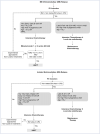Relapsed Acute Lymphoblastic Leukemia
- PMID: 37341952
- PMCID: PMC10791726
- DOI: 10.1007/s12098-023-04635-4
Relapsed Acute Lymphoblastic Leukemia
Abstract
Outcomes for children with acute lymphoblastic leukemia (ALL) have improved worldwide to >85%. For those who relapse, outcomes have remained static at ~50% making relapsed acute lymphoblastic leukemia one of the leading causes of death in childhood cancers. Those relapsing within 18 mo in the bone marrow have a particularly dismal outcome. The mainstay of treatment is chemotherapy, local radiotherapy with or without hematopoietic stem cell transplantation (HSCT). Improved biological understanding of mechanisms of relapse and drug resistance, use of innovative strategies to identify the most effective and least toxic treatment regimens and global partnerships are needed to improve outcomes in these patients. Over the last decade, new therapeutic options and strategies have been developed for relapsed ALL including immunotherapies and cellular therapies. It is imperative to understand how and when to use these newer approaches in relapsed ALL. Increasingly, integrated precision oncology strategies are being used to individualize treatment of patients with relapsed ALL, especially in patients with poor response disease.
Keywords: Chemotherapy; Childhood ALL; Relapse; Transplant.
© 2023. The Author(s).
Conflict of interest statement
None.
Figures


Similar articles
-
Treatment of childhood acute lymphoblastic leukemia after the first relapse: curative strategies.Haematologica. 2000 Nov;85(11 Suppl):47-53. Haematologica. 2000. PMID: 11268324 Review.
-
Management of relapsed acute lymphoblastic leukemia in childhood with conventional and innovative approaches.Curr Opin Oncol. 2013 Nov;25(6):707-15. doi: 10.1097/CCO.0000000000000011. Curr Opin Oncol. 2013. PMID: 24076579 Review.
-
ALL-REZ BFM--the consecutive trials for children with relapsed acute lymphoblastic leukemia.Klin Padiatr. 2013 May;225 Suppl 1:S73-8. doi: 10.1055/s-0033-1337967. Epub 2013 May 22. Klin Padiatr. 2013. PMID: 23700062
-
Use of allogeneic hematopoietic stem-cell transplantation based on minimal residual disease response improves outcomes for children with relapsed acute lymphoblastic leukemia in the intermediate-risk group.J Clin Oncol. 2013 Jul 20;31(21):2736-42. doi: 10.1200/JCO.2012.48.5680. Epub 2013 Jun 17. J Clin Oncol. 2013. PMID: 23775972 Clinical Trial.
-
Mutations in epigenetic regulators are involved in acute lymphoblastic leukemia relapse following allogeneic hematopoietic stem cell transplantation.Oncotarget. 2016 Jan 19;7(3):2696-708. doi: 10.18632/oncotarget.6259. Oncotarget. 2016. PMID: 26527318 Free PMC article.
Cited by
-
Evaluation of methotrexate Pharmacogenomic variation to predict acute neurotoxicity in children with acute lymphoblastic leukemia.Pharmacotherapy. 2025 Jan;45(1):4-11. doi: 10.1002/phar.4638. Epub 2024 Dec 29. Pharmacotherapy. 2025. PMID: 39734275
-
Future perspectives on novel CAR-T therapeutics beyond CD19 and BCMA in onco-hematology.Front Immunol. 2025 Jul 14;16:1592377. doi: 10.3389/fimmu.2025.1592377. eCollection 2025. Front Immunol. 2025. PMID: 40726984 Free PMC article. Review.
-
Management Principles and Advances in Therapies of Pediatric Acute Leukemia: A Comprehensive Snapshot.Indian J Pediatr. 2024 Jan;91(1):35-36. doi: 10.1007/s12098-023-04920-2. Epub 2023 Nov 10. Indian J Pediatr. 2024. PMID: 37945980 No abstract available.
-
Genetic and Epigenetic Biomarkers Associated with Early Relapse in Pediatric Acute Lymphoblastic Leukemia: A Focused Bioinformatics Study on DNA-Repair Genes.Biomedicines. 2024 Aug 5;12(8):1766. doi: 10.3390/biomedicines12081766. Biomedicines. 2024. PMID: 39200230 Free PMC article.
-
Nanodrug Delivery Systems for Acute Lymphoblastic Leukemia Therapy.Pharmaceuticals (Basel). 2025 Apr 27;18(5):639. doi: 10.3390/ph18050639. Pharmaceuticals (Basel). 2025. PMID: 40430460 Free PMC article. Review.
References
-
- Eckert C, Groeneveld-Krentz S, Kirschner-Schwabe R, et al; ALL-REZ BFM Trial Group. Improving stratification for children with late bone marrow B-cell acute lymphoblastic leukemia relapses with refined response classification and integration of genetics. J Clin Oncol. 2019;37:3493–506. - PubMed
-
- Dobson SM, Garcia-Prat L, Vanner RJ, et al. Relapse-fated latent diagnosis subclones in acute b lineage leukemia are drug tolerant and possess distinct metabolic programs. Cancer Discov. 2020;10:568–587. doi: 10.1158/2159-8290.CD-19-1059. - DOI - PMC - PubMed
Publication types
MeSH terms
Grants and funding
LinkOut - more resources
Full Text Sources

